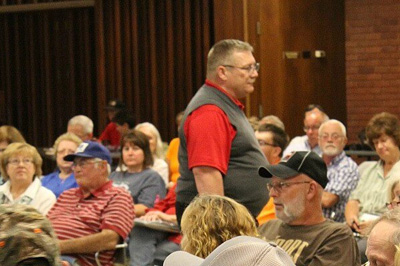Wayne County landowners concerned about new pipelines
Thursday, October 1, 2015

WOOSTER, Ohio — Landowners in Wayne and surrounding counties have yet to see much in the way of shale oil and gas drilling, but they’re in the crossroads of several major interstate pipeline projects that are being planned.
As many as five new pipelines could be built, some that will run across state lines, and at least one, the ET Rover, that measures up to 42 inches in diameter. Other lines being planned include the Utopia and Nexus projects.
The crossroads
Wayne County is located “in the hotbed of activity,” said Dale Arnold, energy director for the Ohio Farm Bureau Federation. Arnold gave an update on proposed pipelines during a Farm Bureau meeting Sept. 28, at the Ohio Agricultural Research and Development Center in Wooster.
Related: April pipeline meeting in Wayne Co.
Joining Arnold were two oil and gas attorneys — Thomas White, of White Law Office in Millersburg, and Craig Wilson, of Emens & Wolper Law Firm, of Columbus — who explained the negotiation phase of the pipeline leases, and some of the things landowners can and cannot do.
Related: Kinder Morgan VP gives update on Utopia East pipeline Jan. 12, 2016
Gaining access
According to Wilson, landowners are being approached, and also sued, to file surveys through eminent domain, and to gain access to easements. He said as driller and pipeline budgets continue to shrink, those kinds of activities will likely continue. But, as Arnold pointed out, pipelines that do not cross state borders (intrastate) are not considerations for eminent domain. The attorneys added, however, that those determinations are being challenged, and that the law is still “gray” over how far eminent domain can be applied.
The biggest pipeline being planned is the ET Rover, a 710-mile project that would carry natural gas across Pennsylvania, West Virginia, Ohio, and Michigan. According to the company’s website, Rover expects to begin using the pipeline as early as late 2016. But Wilson said the project is not moving along as fast as the company had hoped.
“Rover is in serious crunch time at this point and time,” said Wilson, who said Rover only has about 25 percent of its pipeline rights-of-way bought — compared to the 80 percent the company had expected by this time.
Federal approval
Rover is still applying for final approval through the Federal Energy Regulatory Commission, which is expected to release the project’s Environmental Impact Statement any day. Once the EIS is released, a public comment period will follow. The main public concerns over Rover deal with the loss to farmland, residential and business impact, and the potential disruption of emergency services. Wilson said his clients are particularly concerned about potential damage to water drainage structures, like tile.
“That is the major issue for most people, is how are they going to repair my drainage tile and will it be done properly,” he said.
Remedial concerns
Wayne County landowner Roger Meggyesy said Rover will make a diagonal strip across his farm, and he’s worried that the topsoil and tiling won’t get put back properly to sustain the same yields and farming practices he now enjoys.
“That land is going to take a long time to come back,” he said. “I don’t see anything laid out right now for proper remediation practices.”
While landowners may not be able to stop the pipelines, Arnold said they can control what happens with a good lease that covers all of the ways the land will be impacted. That includes the loss of at least two years of crops, plus the potential loss of trees, and future land use plans, as well as future taxation.
According to Wilson, the Rover route is about 99 percent final, but routes for other lines may have more wiggle room. The Kinder Morgan line, for example, has been re-routed multiple times, based on concerns.
“It’s important to go to the pipelines early if you don’t want the routing where it is,” Wilson said.
The Utopia project, (built by Kinder Morgan) has begun making offers to landowners, Wilson said, of about $7,000 an acre for a permanent right-of-way, and $2,100 an acre for temporary workspace. Because that line is intrastate (doesn’t cross state lines), it is not regulated by FERC. That means landowners and the state should have more control.
“Basically the township trustees and you are the ones who regulate the pipeline,” Wilson said. “And you regulate them by types of easements you put on them.”
Mediation
Although some landowners are already being threatened with lawsuits if they don’t allow surveying, both attorneys said landowners should not fret. For one thing, Rover can’t use eminent domain until the project is approved by FERC.
If the Rover pipeline achieves federal approval, then the company can sue if it chooses. But, as White pointed out, most of those cases can usually be solved through mediation, and in terms that are agreeable to the landowner.




